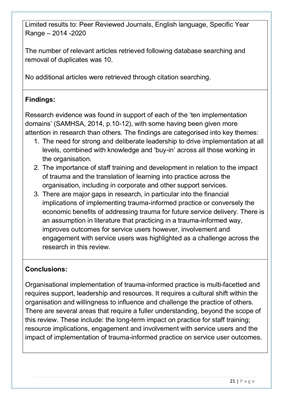
21 | P a g e
Limited results to: Peer Reviewed Journals, English language, Specific Year
Range - 2014 -2020
The number of relevant articles retrieved following database searching and
removal of duplicates was 10.
No additional articles were retrieved through citation searching.
Findings:
Research evidence was found in support of each of the 'ten implementation
domains' (SAMHSA, 2014, p.10-12), with some having been given more
attention in research than others. The findings are categorised into key themes:
1. The need for strong and deliberate leadership to drive implementation at all
levels, combined with knowledge and 'buy-in' across all those working in
the organisation.
2. The importance of staff training and development in relation to the impact
of trauma and the translation of learning into practice across the
organisation, including in corporate and other support services.
3. There are major gaps in research, in particular into the financial
implications of implementing trauma-informed practice or conversely the
economic benefits of addressing trauma for future service delivery. There is
an assumption in literature that practicing in a trauma-informed way,
improves outcomes for service users however, involvement and
engagement with service users was highlighted as a challenge across the
research in this review.
Conclusions:
Organisational implementation of trauma-informed practice is multi-facetted and
requires support, leadership and resources. It requires a cultural shift within the
organisation and willingness to influence and challenge the practice of others.
There are several areas that require a fuller understanding, beyond the scope of
this review. These include: the long-term impact on practice for staff training;
resource implications, engagement and involvement with service users and the
impact of implementation of trauma-informed practice on service user outcomes.